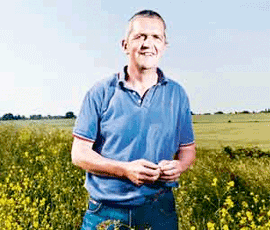In-cab technology threatens ‘public bar barley blarney’

I don’t know about you, but I’m sure I can remember a time when harvests seemed a little more ‘cavalier’ than they are now.
As a boy, one of my tasks was to take cans of beer out to combine drivers and the trailer gang in the evening as an incentive to work late in the harvest rush. This provision was probably the last knockings of a time when harvest labour was, in part, paid for with beer or cider. A hundred years ago farm workers would anesthetise themselves from the drudgery of their work with a gallon of beer a day provided by the farmer. In our safety-conscious age it is quite a thought to imagine an inebriated workforce staggering around unguarded machinery while armed with razor-sharp blades.
Although these days of intoxicated farmyards are mercifully now past, maybe there is another vestige of this in what is commonly known as ‘pub yield syndrome’. For some reason, in the frothy environment of the local pub, the magnitude of neighbouring farms’ harvests are compared with fortified relish. Just as the barmaids get prettier, so too yields get bigger as more pints are drunk. Poorer-yielding fields become forgotten and acreages are shrunk to make the piles in our barns greater than they actually are.
I will confess to being caught up in this syndrome myself, to the point that I have been admonished for my colourful talk of a bumper harvest. There is a belief among some in the farming fraternity that this sort of exaggeration can actually talk prices down. Personally, I’m not convinced that careless chat about good yields in north-east Essex instantly filters down to the trading floor of the Chicago Board of Trade where the global price for wheat is set, but clearly there are those who are.
But it occurs to me that this fine tradition of public bar barley blarney may be being brought to an end by in-cab technology. Increasingly, if pub yields can’t be backed up by records on a hand-held device sent from a GPS-aligned yield meter, then they are dismissed as old hat.
Where our fathers roughly counted the trailer loads from each field, today we cite our exact yields to two decimal places. Even worse, these in-cab computers even send field performance data to third parties such as machinery manufacturers. It’s as if there is a new deity up there who knows the truthfulness of our anecdotal harvest reports. The question is, are these reports of wall-to-wall 10t-plus crops we read about in the farming press about to be found out by the fact that the average UK wheat yield is actually eight.
Mind you, I’ve heard on the grapevine that some farmers calibrate their yield meters with wildly high bushelweights more akin to dry sand than cereals, thereby adding another 20-30% to yield.
Having spiked your yield meter, the trick is to wait until you are in the thickest part of the crop then take a picture on your phone of the yield reading as it flickers into two digits. Later in the pub, as the third pint goes down, such pictorial proof on your hand-held device can be used to out-trump all your neighbours. Of course, fiddling around in the combine cab when you think no one is watching in order to try to make yourself look more impressive than you actually are is pathetic. You are not just letting yourself down, you are letting those around you down as well. In fact, thinking about it, the sooner I stop doing it the better.
Guy Smith comes from a mixed family farm on the north-east Essex coast. The farm is officially recognised as the driest spot in the British Isles. Situated on the coast close to Clacton-on-Sea, the business is well diversified with a golf course, shop, fishing lakes and airstrip.

